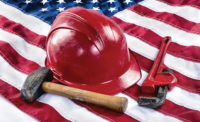The bottom line question entering 2017 – and every year – what do resource allocations look like for safety and health departments?
Pretty much what you’d expect, given the challenging economic headwinds that we report many vendors describing elsewhere in this issue of For Distributors Only. Almost half (43 percent) of the ISHN reader respondents to our 2017 forecast survey say their safety and health budgets will remain flat in the coming year. About an equal percentage (42 percent) anticipate a slight bump up in budget funds. More than one in ten (12 percent) are looking at a slight decrease in spending.
Nothing drastic is in store. The status quo rules. Significant budget increases are reported by only two percent of survey respondents, and only one percent report a significant decrease.
The same holds true for safety and health department headcounts. The overwhelming majority, almost seven in ten respondents (69 percent) report staff size will stay the same in 2017. About one-quarter (23 percent) expect a slight increase in headcount, mostly in the construction industry. There will be no bloodletting in departments: only five percent of respondents report a slight decrease in staffing, and only one percent report significant cuts.
Products in demand
When we ask professionals about the top hazards they confront on their worksites, you can equate it to the types of safety and health products they will be purchasing in 2017 to mitigate those hazards. The top hazards (ranked in order):
- Ergonomics
- Falls
- Hand and arm injuries
- Lifestyle health issues
- Lockout-tagout
- Motor vehicle safety
- Eye and face injuries
- Electrical safety
- Stress and mental health
- Chemical exposures
- Respiratory protection
- Noise
Your customer’s mindset
Intelligence on what’s on the mind of your customer entering the new year – job challenges, top goals, and how they feel about their jobs – is always good to have in hand.
Here are the top five challenges facing professionals:
- Employee behavior / consistent safe behaviors
- Putting safety on equal footing with production
- Safety training of employees
- Getting senior leadership “buy in” for safety and health
- OSHA compliance
Here are the job challenges with the least impact:
- Employee legal use of controlled substances/medications
- Supply chain management
- Employee illegal substance abuse
- Off the job injuries
Ways you can help (service options)
Safety distributors for years now have placed increased emphasis on providing services to customers. One way to align your services to customers’ needs is to look at the top goals they have. Can you be of service to these goals? In 2017, ISHN’s survey reports professionals have these top goals (ranked in order):
1 Build / maintain a safety culture
2 Reduce serious injuries and fatalities
3 Lower OSHA recordable incident rate
4 Lower workers’ compensation cost
5 Get senior leadership support
6 Develop and track key performance indicators
Attitudes about the safety job
ISHN surveys over the decades show a correlation between how readers feel about their jobs and the state of the economy. When we’re in a recession and/or period of downsizing, of course job stress and job security concerns go up. That’s not the case going into 2017. The economy has been stable with incremental growth since the Great Recession of 2008, and that stability is reflected in the work attitudes of safety and health professionals.
For example, only 23 percent report personal job stress to be a significant issue entering 2017. Expanding work hours are having a major impact on only 20 percent.
Job satisfaction and job security are holding steady. About three in four survey respondents report their job satisfaction will remain the same in 2017 (76 percent), and the same percentage report their job security will remain the same. Only six percent expect their job satisfaction to diminish, and only ten percent say their job security will worsen. In years past, during hard economic times, upwards of 20-30 percent of professionals have had job security concerns. That was then, this is now.
In fact, about one in five pros (19 percent) say job satisfaction will improve in 2017, and 14 percent say job security will improve.
In terms of salaries, safety and health pros are in the same boat as most of the working population: most (54 percent) expect a slight bump up in pay in 2017, and 38 percent expect no change in pay. Only three percent expect a significant raise. And only five percent expect a lower salary.
Reporting lines
Finally, it’s helpful for distributors to know who ultimately holds the purse strings for safety and health spending. Who do safety and health pros report to? We asked the question, and here are the results:
- 40 percent report to the CEO or owner (mostly in smaller companies and privately-held companies)
- 36 percent report to operations
- 25 percent report to human resources
- 9 percent report to quality
- 8 percent to environmental
- 8 percent to engineering
- 5 percent to legal
- 10 percent to other functions (sales, purchasing, etc.)




